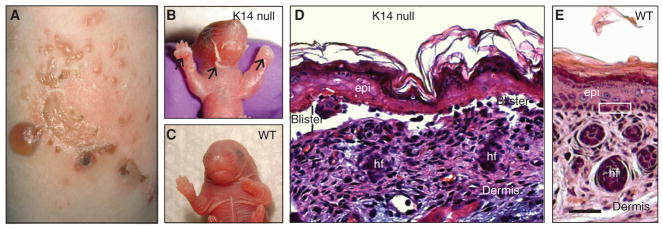Figure 3.
Loss of keratin K14 elicits epidermolysis bullosa simplex (EBS)-like features in mouse skin. (A) Leg skin in a patient suffering from the Dowling–Meara (severe) form of EBS. Characteristic of this severe variant of this disease, several skin blisters are grouped in a herpetiform fashion. (BC, ) Images of newborn mouse littermates, comparing K14-null and wild-type (WT) mice. The K14-null neonate shows massive skin blistering. The front paws and facial area are severely affected (arrows); by comparison, a WT littermate shows intact skin. (DE, ) Micrographs from hematoxylin/eosin-stained histological sections prepared from the front paws of 2-d-old K14-null and WT mice. Epidermal cleavage is obvious in the K14-null sample. Loss of epidermal integrity occurs through the basal layer of keratinocytes (labelled “blister”)—the defining characteristic of EBS. Three basal keratinocytes are boxed in E. epi, epidermis; hf, hair follicle. Scale bar, 100 μm. (A, Reprinted from Coulombe et al. 2013; B–E, adapted from Coulombe et al. 2009.)

